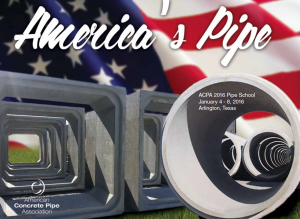The American Concrete Pipe Association (ACPA) applauds the U.S. Congress for including the Disaster Recovery Reform Act (DRRA) in the final version of the H.R. 302, the “FAA Reauthorization Act of 2018.”
The Disaster Recovery Reform Act will shift the U.S. Government’s approach to disaster recovery by placing more emphasis on preparing for disasters and mitigating the risk to infrastructure rather than simply responding in the aftermath of a disaster. It is estimated that this new approach will save taxpayers $4 to $8 for every $1 invested before a disaster strikes, help communities rebound faster, and reduce the cost of recovery.
In addition, the Act will encourage State and local governments to build or rebuild infrastructure that is stronger and better able to withstand the destructive forces of hurricanes, fires, floods, and other natural disasters.
ACPA is particularly pleased to see that concerns about the resilience of evacuation routes have been addressed. In the run-up to a hurricane or severe flood, when people are trying to get out of harm’s way, we rely heavily on the roads designated as evacuation routes. Given the life-protecting role that evacuation routes play, these roads must be able to withstand the forces of nature to provide a fast, efficient means of escape for area residents as well as a means of returning home in the aftermath of a disaster.
ACPA appreciates the work of the House Transportation and Infrastructure Committee in crafting this legislation. It was a much-needed effort that will, when signed into law, improve this Nation’s ability to withstand future natural disasters and better protect taxpayers’ investments in infrastructure.
ACPA looks forward to final passage of the legislation and to working with the Executive Branch to ensure that these vital reforms are implemented swiftly.


